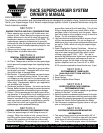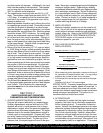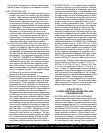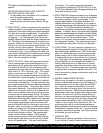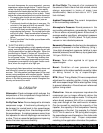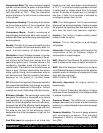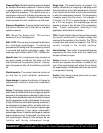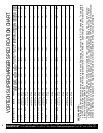
6
© 2000 Vortech Engineering, Inc. All Rights Reserved. International Copyrights Secured. 25FEB00 V 2.0 DRAFT P/N: 008515
Questions?
Please contact: Vortech Engineering, Inc. • 1650 Pacific Ave., Channel Islands, CA 93033-9901
Phone: (805) 247-0226 • Fax: (805) 247-0669 • Website: vortechsuperchargers.com • Hours: M-F 8AM - 4:30PM (PST)
Compression Ratio: The ratio of maximum engine
cylinder volume (when the piston is at the bottom
of its stroke) to minimum engine cylinder volume
(with the piston at TDC). Thus, the theoretical
amount that the air to fuel mixture is compressed
in the cylinder.
Compressor Housing: The housing which makes
up the enclosure portion of the compressor. Also
referred to as the volute, scroll or snail.
Compressor Maps: Graphic summaries of
supercharger performance data (with respect to
pressure and flow) generated using test equipment
and procedures.
Density: The ratio of the mass of something to the
volume it occupies. Air has less density when it is
warm, and less density at higher altitudes.
Detonation: (Knock) Sudden increase in cylinder
pressure caused by pre-ignition of some of the air-
fuel mixture as the flame front moves from the
spark-plug ignition point. Pressure waves in the
combustion chamber crash into the piston or
cylinder walls. This results in the sounds known as
knock or ping. Strongly influenced by fuel octane
rating, ignition timing, and compression ratio as
well as boost level. May be caused by hot carbon
deposits on the piston or cylinder head.
EFI: (Electronic Fuel Injection) A computer controlled
fuel system that distributes fuel through an injector
located in each intake port of the engine. The fuel
injectors are usually fired using individual circuitry.
Efficiency Islands: The percentage values that
designate the efficiency expressed in an island
representation on a compressor map. The area
inside the island designates maximum efficiency,
the area to the left of the efficiency island designates
the temperature is too high on the surge side, and
the area to the right of the efficiency island
designates that drive horsepower is high on the
choke side.
Fuel Rich/Lean: An evaluation of air to fuel ratio
based on an air-fuel value known as stoichiometric
or 14.7:1. In most fuel injection systems rich/lean
is determined by voltage signal from the oxygen
sensor. An excess of oxygen lean is a voltage of
less than .4 volts. A rich condition is indicated by
a voltage of greater than .6 volts.
FMU: (Fuel Management Unit) A vacuum/boost
referenced fuel pressure regulator. Used to increase
the pressure by regulating fuel flow returning to the
tank from the stock fuel pressure regulator.
Impeller: The finned or bladed rotating wheel
housed inside the volute.
Inducer: The air inlet portion of a centrifugal
compressor.
Intercooler: A heat exchanger which reduces the
temperature of the air between stages of
compressors or superchargers.
MAF: (Mass Air Flow Sensor) An electric hot wire
used to measure the mass or weight of intake air.
MAP: (Manifold Absolute Pressure [or its signal
circuit]) Manifold pressure measured on the absolute
pressure scale, an indication of engine load. At sea
level, with the engine off,
MAP=100 kPa (14.7 PSIG)
Naturally Aspirated: An engine without a
supercharger.
PCV: (Positive Crankcase Ventilation) Engine
crankcase fumes ducted back to the intake manifold
to reduce air pollution.
Pressure Boost: The difference in pressure
between barometric and intake manifold absolute
pressure on a supercharged engine (read as gauge
pressure).
Pressure Absolute: The sum of gauge pressure
and atmospheric pressure. One standard
atmosphere = 29.92 in. of mercury (Hg) = 14.696
lb/in (PSI).



